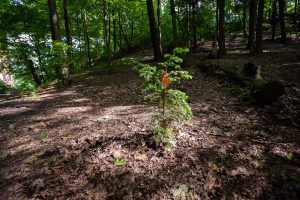
Environment
Toronto city council votes to save historic red oak
The fight to save the city’s oldest tree is over, and Zhelevo has won
- 986 words
- 4 minutes
Environment

Coral Gable Drive in Toronto’s North York is the picture of an established suburb, with tidy bungalows set back on wide green lawns. Yet among its mature maples and oaks, one tree stands out: a sprawling red oak named Zhelevo that from the street appears to have consumed the house at number 76.
Standing 24 metres high, with a trunk circumference of 495 centimetres, the tree is approximately 300 years old, making it older than the city itself. Recognized as a heritage tree by Forest Ontario’s Heritage Tree Program since 2009, the tree is currently protected under the City of Toronto’s Private Tree By-law. The current homeowners are looking to sell the property, and new owners could apply for a permit to have the tree taken down. But a group of concerned citizens is determined to see Zhelevo preserved.
“I don’t go to church,” says conservationist and preservation activist Edith George, “but when that Ukrainian plane was shot out of the air [in Iran]; when Australia was on fire; and now with COVID … That tree is my cathedral.”
As an advisor to the Ontario Urban Forest Council and an expert on heritage trees, George has been advocating for the protection of the tree for more than 14 years. She says you cannot understand the magnitude of the tree until you see it in person. “The fact that you have a specimen like that in an urban setting that has never been felled by the axe, by any of the owners, is just unbelievable.”
Located near Summerlea Park, the Humber River and the Toronto Carrying-Place Trail, the tree could have previously acted as a marker on the historic fur-trading route, says George. “These trees can tell the stories of this land.”
Watch: Edith George explains what Zhelevo means to her
Named by George after the Macedonian word for “roots,” Zhelevo’s branches cover the roof of the home below it, and the tree’s root system has met the building’s foundation, putting the structural integrity of the house at risk. In Ontario, an oak can live for 450 years, says Mark Cullen, an expert gardener and tree advocate. According to Cullen, the tree is in good health and there is no practical reason why it should be cut down.
“It represents every moment in our city’s history over the last 300 years,” he says. “For that reason alone, we absolutely have to save this tree. If we don’t save it, then what does that say about the citizens of Toronto and the value that we put on our history and the lessons that it teaches us?”

Are you passionate about Canadian geography?
You can support Canadian Geographic in 3 ways:

Environment
The fight to save the city’s oldest tree is over, and Zhelevo has won

Environment
Changes to the city’s Green Standard aimed at protecting its fragile ravine network will pose challenges and opportunities for landscapers — and could kick off a national trend

Environment
Timber poaching has become “a problem in every national forest,” with an estimated $1 billion worth of wood poached yearly in North America

Environment
David Boyd, a Canadian environmental lawyer and UN Special Rapporteur on Human Rights and the Environment, reveals how recognizing the human right to a healthy environment can spur positive action for the planet